A Private Tour today in N Norfolk. It was rather cool and cloudy, with an increasingly blustery west wind in the afternoon and no sign of the promised sunny intervals, but it was dry all day.
The main target for the day was to try to find warblers and, if possible, Garganey. Snettisham seemed like the best bet, so we set off west along the coast road. A quick stop on the way at Titchwell and there was no sign of the Turtle Dove which had been in the car park early yesterday morning. The weather wasn’t particularly conducive, so we didn’t stop here long.
Arriving at Snettisham, we set off to explore the Coastal Park. As soon as we parked, we could hear warblers singing. A male Blackcap perched up obligingly in the top of a bush and a Common Whitethroat was songflighting, before landing on a tall bramble stem. We quickly heard our first Lesser Whitethroat of the day and set off along one of the smaller paths to try to see it. They can be elusive at this time of year at the best of times, often singing from deep in the bigger bushes. We did manage to see the Lesser Whitethroat a couple of times as it flew across between hawthorns, but it was perhaps too much to hope that it might come out and sing for us on a cool morning like today.
The Chiffchaffs and Willow Warblers were a little more accommodating. There were good numbers of both singing in the park today. Willow Warbler in particular is not as widely distributed as it used to be so it is always nice to hear their distinctive song, a sweet descending scale, at this time of year. A pair of Bullfinches in the bushes were a nice, non-warbler, addition to the day’s list.
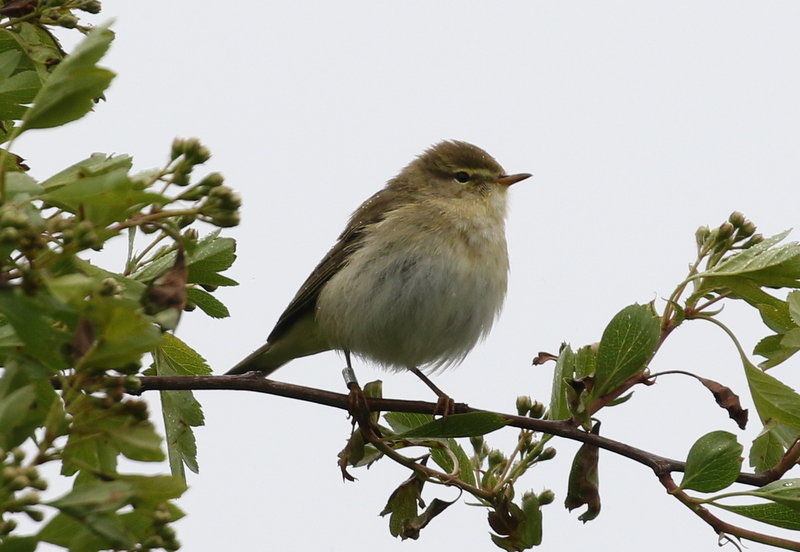 Willow Warbler – several singing in the park today, this one taken yesterday
Willow Warbler – several singing in the park today, this one taken yesterday
An occasional resident Cetti’s Warbler shouted at us from the bushes as we walked past and the damper areas in the middle were alive with singing Sedge Warblers today. They are really back in force now and making their presence known. There are smaller numbers of Reed Warblers which have returned so far, but we did hear a few as we explored the area. One was singing from the reeds by one of the paths which cross through the middle of the park, but despite our best efforts we could not see it – it was keeping tucked well down in the reeds this morning.
As we walked in through the park earlier, we had seen couple of large flocks of Knot circling distantly out over the Wash beyond the sea wall. As we walked back towards the sea wall out of the reeds, we heard loud calls ahead of us and looked up to see two Peregrines chasing each other over the bank. They had presumably been spooking the waders on the Wash earlier!
One of the Peregrines quickly disappeared away beyond the bank, but the other, a juvenile, circled towards us and right over our heads, before heading off north over the park. Great stuff!
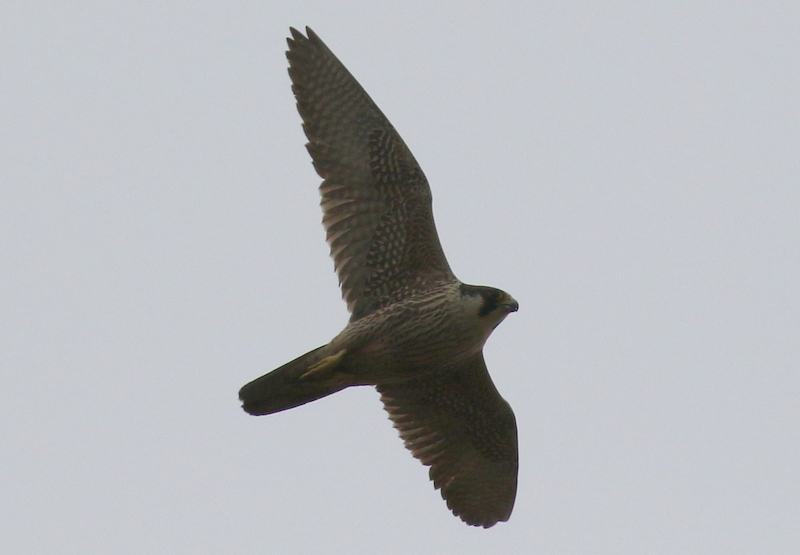 Peregrine – this juvenile came right over our heads, in from the Wash
Peregrine – this juvenile came right over our heads, in from the Wash
This is often a good spot to see Cuckoos at this time of year, and we were not to be disappointed today. After we heard our first singing male in the middle of the Coastal Park, we were never far away from one. It really made it feel like spring, to hear Cuckoos singing, despite the not particularly spring-like conditions.
There were at least three Cuckoos here today, possibly more – it was hard to tell as they were flying around constantly, with birds regularly passing overhead whenever we looked up. They have a few regular bushes from which they like to sing and we got great views through the scope of one male in particular, from up on the inner seawall, when it returned to one of its favourite song posts.
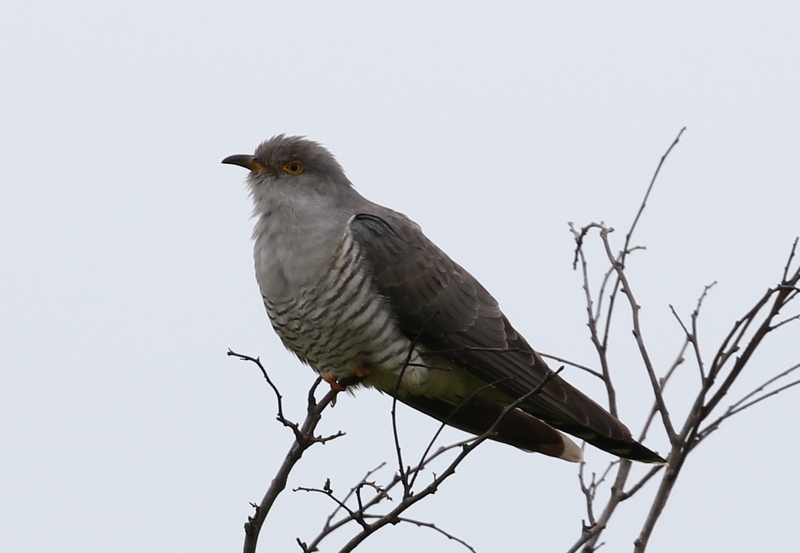 Cuckoo – this photo taken yesterday, but singing from the same tree again today
Cuckoo – this photo taken yesterday, but singing from the same tree again today
Grasshopper Warbler was one species of warbler we had expected to at least hear here today, but as we passed the first couple of areas where birds have been reeling recently, all was rather quiet. Thankfully, as we walked along the path further up we heard the distinctive song of a reeling Grasshopper Warbler, sounding more like an insect than a bird. Helpfully, it was in an area of quite open bushes with a narrow path running through, so we set off in pursuit.
We could see the Grasshopper Warbler perched up in the top of some brambles, so we stopped and set up our scopes. Typically, just as we got them lined up, it dropped back into cover. We walked round to one side of the brambles and positioned ourselves, thinking it might come up again to sing further along the clump. After a few seconds it did just that – half hidden at first and then climbing up right out in full view, up onto some thin rose stems. We had a great view of it through the scope.
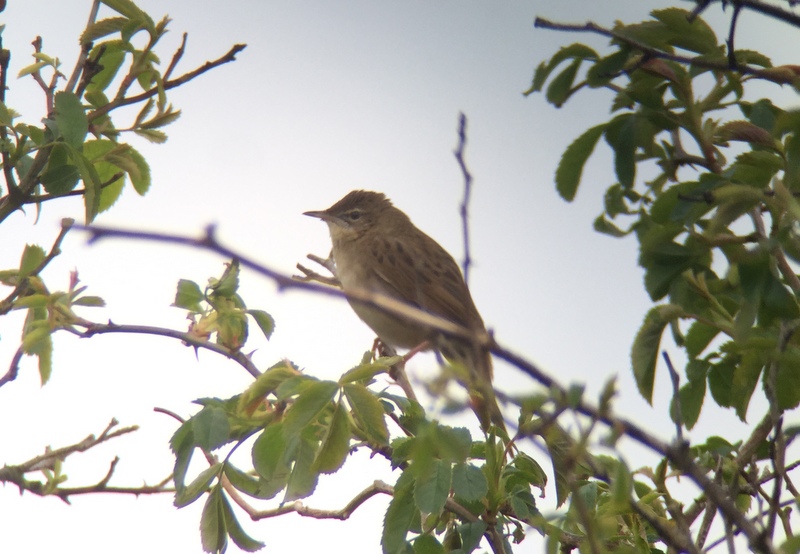 Grasshopper Warbler – reeling from a bramble clump this morning
Grasshopper Warbler – reeling from a bramble clump this morning
In the end, we heard at least three reeling Grasshopper Warblers as we walked round here today. They were possibly just a bit slow to get going this morning!
While we were waiting for the Grasshopper Warbler to reappear, we watched one of the Cuckoos flying over beyond and it swooped down towards a large hawthorn bush and flushed a second Cuckoo from the top of it. The two of them proceeded to chase each other round over the bushes, coming very close to us at one point, just as the Grasshopper Warbler reappeared. We didn’t know which way to look!
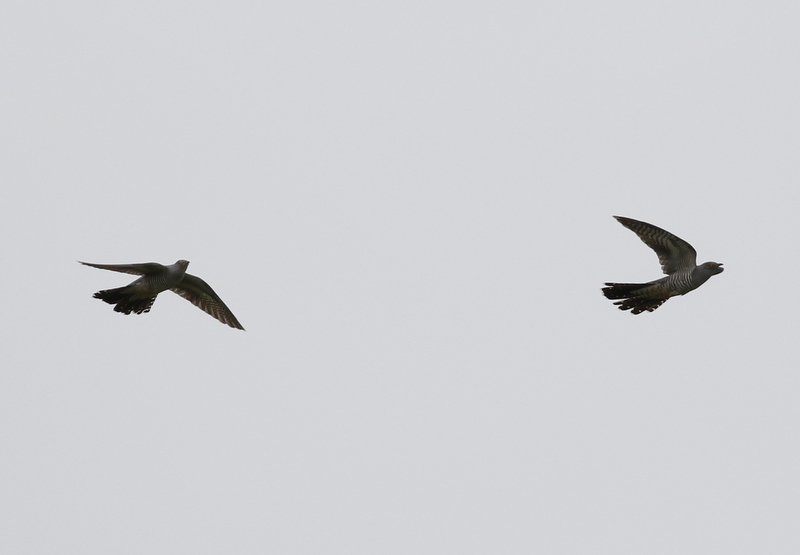 Cuckoos – chasing each other over our heads as we watched the Grasshopper Warbler
Cuckoos – chasing each other over our heads as we watched the Grasshopper Warbler
After completing our target set of warblers for the morning, we walked up as far as the cross bank and climbed up onto the seawall to look out over the Wash. There are still good numbers of waders here at the moment. The tide was still about half way out, but through the scopes we could see them all out on the mud. There were several hundred Knot, most still in grey winter plumage but a few starting to go orange. The same was true of the Bar-tailed Godwits and Grey Plover, though a couple of the latter were already looking quite smart with black bellies and white spangled upperparts.
There were a few smaller waders in amongst the Knot out towards the shoreline, mostly Dunlin but a careful scan produced a single silvery grey and white Sanderling. There were more flocks of Dunlin closer to us, scattered across the mud, and in with them we found a single Ringed Plover. We lost sight of it when the flock flew, but the next thing we knew it appeared on the beach in front of us and started displaying with a second Ringed Plover, the two of them flying round over the sand with stiff wing beats.
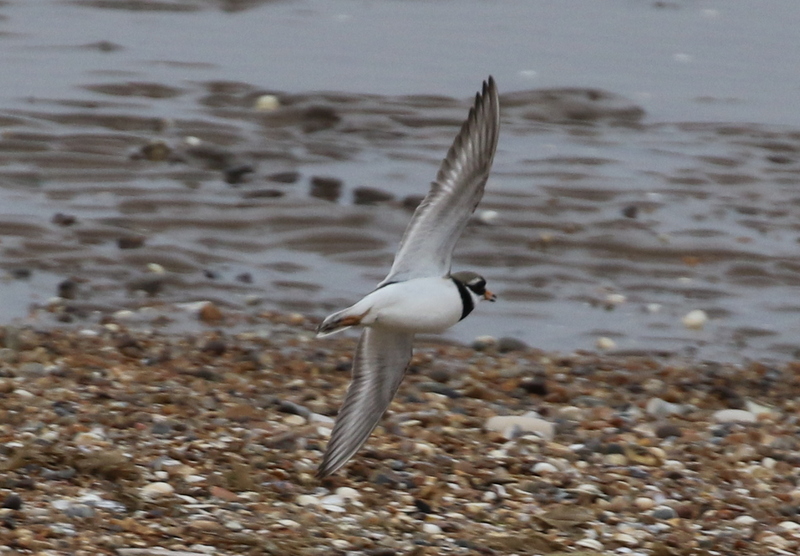 Ringed Plover – two were displaying over the beach
Ringed Plover – two were displaying over the beach
There were a few Curlew out on the mud, but the Whimbrel seem to prefer to feed on the short grass. Looking across on the inland side of the seawall, we found two Whimbrel walking around beyond the pools, nice spring migrants for the trip list.
The Wash coast is a good place to watch visible migration (or ‘vizmig’ for short), with flocks of birds passing overhead on their journeys, being forced south here if they want to avoid crossing the Wash on their way north along the coast. There were a few birds moving today, but it was possibly a bit slow due to the weather. We did have several small flocks of Meadow Pipits passing overhead, along with a few Linnets and Goldfinches. A single White Wagtail dipped low enough over the bushes that we could see its pale grey back before continuing south along the seawall. There was a steady trickle of hirundines moving all morning – almost entirely Swallows today, apart from one House Martin which we managed to catch as it flew through.
There had been a pair of Garganey here in the last week or so, although there was apparently no sign of them yesterday. We headed over to the inner seawall to scan the pools to see if we could find them. They were not on the pools today where they had been previously, but we did see a nice selection of other wildfowl. Two small flocks of around 30 Pink-footed Geese each were out on the grass. Most of the Pink-footed Geese have long since departed on their way north to Iceland for the breeding season, but these few were leaving it rather later. There were also the resident Greylag, Canada and Egyptian Geese here. Ducks included Teal, Gadwall, Shoveler and a few lingering Wigeon.
The wind was starting to pick up now and it was rather cold up on the inner seawall, so we opted to walk back through the shelter of the bushes. We should have continued south along the inner seawall as, little did we know at that stage, but the Garganey were on another pool back towards the road. Thankfully, we bumped into another couple of birders on our way back who told us about them and we were able to cut back across and up onto the bank to look. We found the drake Garganey tucked tight up against the bank of the pool asleep, sheltered from the wind. Through the scope we could still see its distinctive white head stripe and the elongated ornamental feathers hanging down over its flanks.
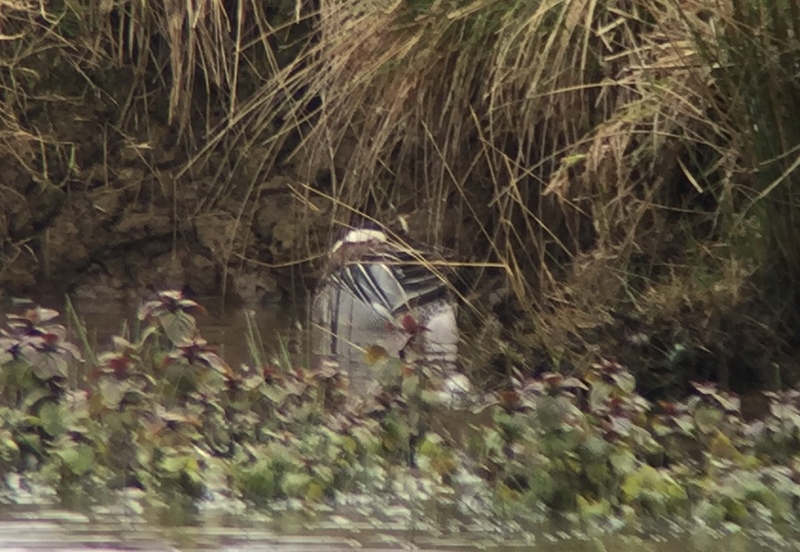 Garganey – asleep, tucked into the edge of one of the pools
Garganey – asleep, tucked into the edge of one of the pools
It was getting on for lunchtime when we got back to the car, so we drove inland to a sheltered spot for lunch. Afterwards, we had a quick walk out onto Dersingham Bog. We had hoped to find a Tree Pipit singing here, but it was a bit cold and windy and a quiet time of the day now. They are summer visitors so they may not all be back in here yet. We did find a couple of pairs of Stonechat and flushed a Green Woodpecker from beside the path. It quickly became clear it was rather quiet here so we didn’t stay long.
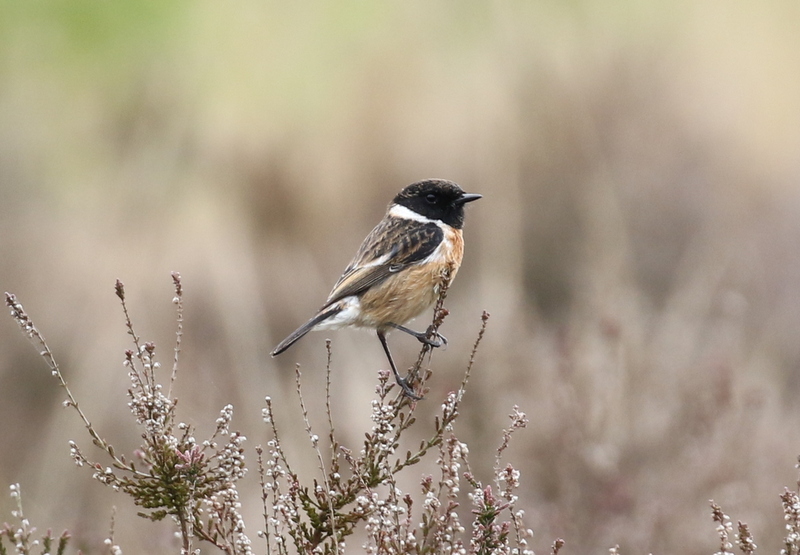 Stonechat – Dersingham Bog is a good place for this species
Stonechat – Dersingham Bog is a good place for this species
Grey Partridge was another target species for the afternoon. They are sometimes to be found at Snettisham, but they can be disturbed by the large number of dog walkers here. We took a diversion on our way back, inland via Ringstead. This is often a good area for Grey Partridge and a stop to scan a likely looking field quickly found us a pair, with a second pair on the edge of a field as we dropped back down to the coast road at Choseley.
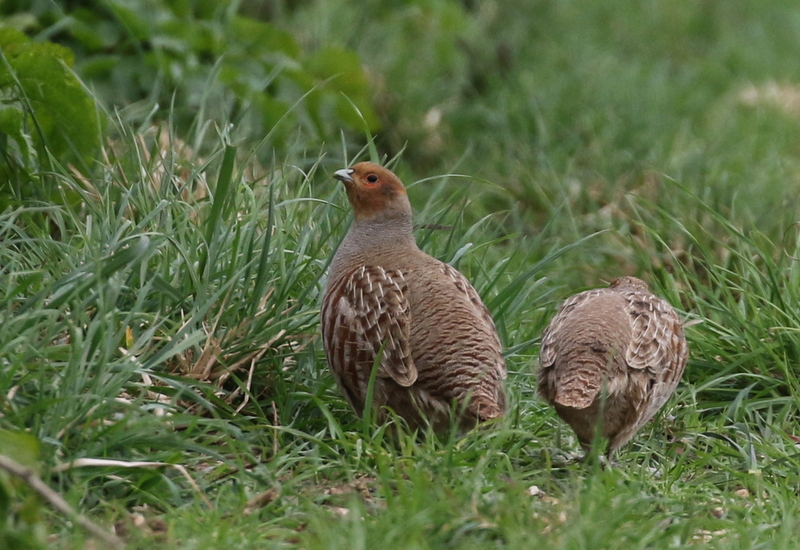 Grey Partridge – one of two pairs we found on our short diversion inland
Grey Partridge – one of two pairs we found on our short diversion inland
Our destination for the remainder of the afternoon was Holkham. We made a quick stop to scan the grazing marshes from the road and were rewarded with distant views of several Spoonbills in the trees. A long, snaking white head appeared occasionally out of an overgrown ditch and eventually a Great White Egret climbed out, helpfully with a Grey Heron then walking right in front of it to give a great size comparison. It then flew off back into the trees. There were several Barnacle Geese out on the grazing marshes too, presumably feral birds from Holkham Park.
Driving round to Lady Anne’s Drive, we headed out along the path to the hides. It was rather quiet in the trees in the strengthening breeze. A few Chiffchaffs were singing, along with a couple of Sedge Warblers from the reeds in front of Washington Hide. We did manage to find a Treecreeper hiding in a holm oak by Meals House. Then as we approached Joe Jordan Hide, we finally heard a Willow Warbler singing, usually a fairly regular sound here in spring.
There was a large white bird standing on the edge of a ditch out on the grazing marsh between Meals House and Joe Jordan Hide – a Great White Egret, possibly the same one we had seen earlier. In the breeding season the bill can go black, making it look rather more similar to a Little Egret. A couple of Greylag Geese walking in front of it left us in no doubt as to its large size. Through the scope we also admired the bright blue-green facial skin at the base of its bill. A couple of drake Pintail out on one of the pools beyond were a nice surprise.
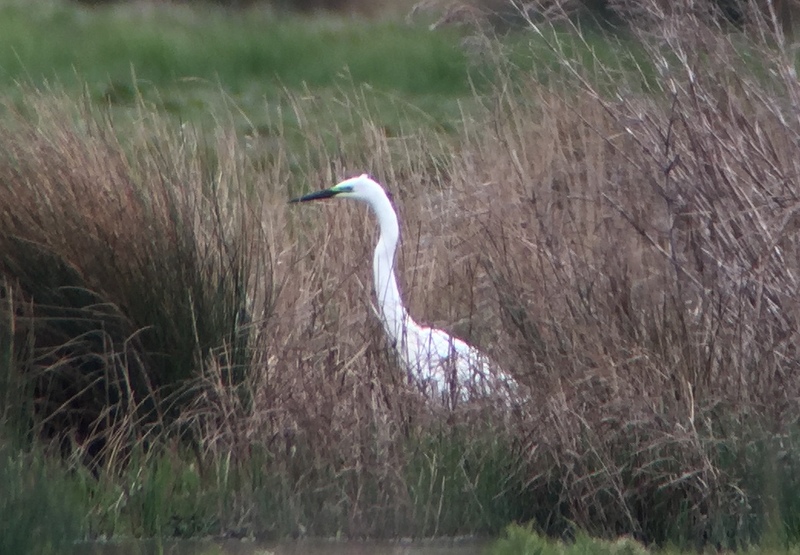 Great White Egret – in a weedy ditch out on the grazing marsh
Great White Egret – in a weedy ditch out on the grazing marsh
From up in the Joe Jordan Hide, it didn’t take long to find a Spoonbill, perched up obligingly in the top of the sallows behind the fort. They were coming and going pretty much constantly from the trees while we were there. Several flew down to the pool below to collect nest material, before carrying it back up to the trees. Others were flying in and out from further along the coast in both directions, where they had presumably been feeding. We could see the bushy nuchal crest on the breeding adults, as well as the mustard yellow wash across the breast.
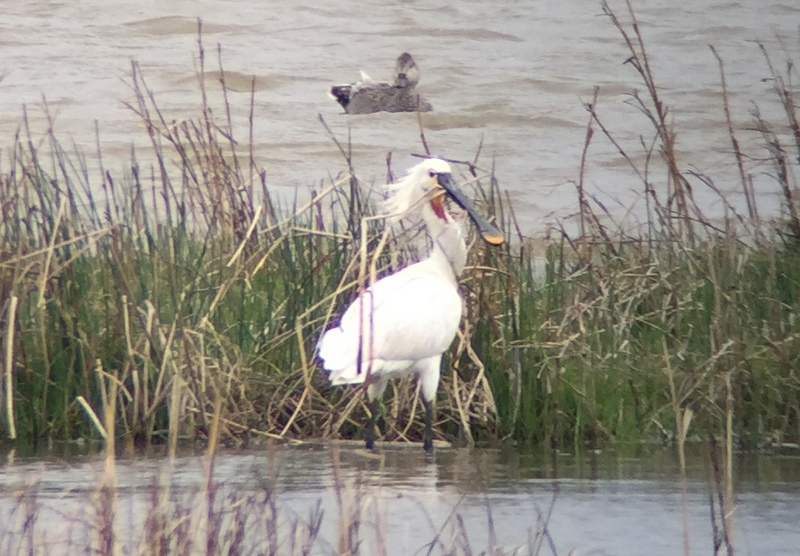 Spoonbill – collecting nest material
Spoonbill – collecting nest material
There were other birds coming and going here too. Lots of Marsh Harriers were quartering out over the marshes and a nice male came through close in front of the hide. A Red Kite circled lazily over Holkham Park and a Sparrowhawk flapped up distantly out of the trees. There are plenty of Common Buzzards here too, including a couple of rather striking pale ones which are always a source of confusion for the unwary.
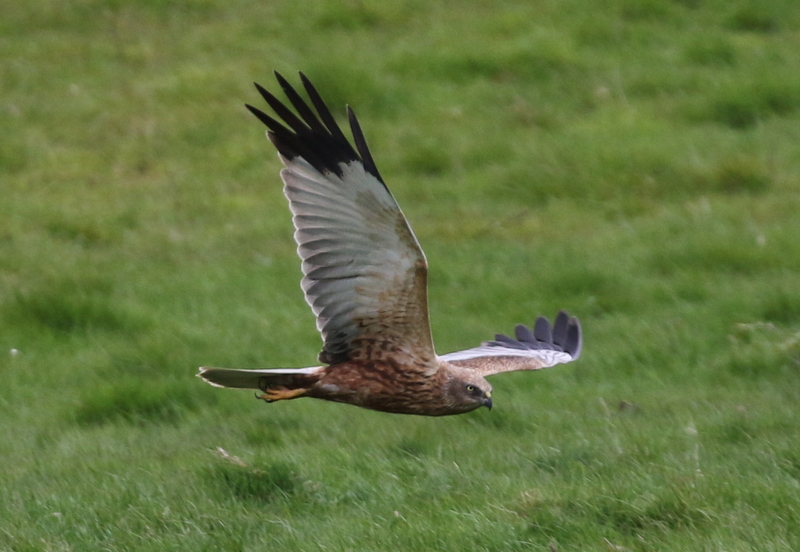 Marsh Harrier – this male flew past in front of the hide
Marsh Harrier – this male flew past in front of the hide
Three House Martins were lingering over the trees, hawking for insects. A few Swallows were still making their way west, along with a couple of Sand Martins. A single Pink-footed Goose, presumably a sick or injured bird which is destined to stay here for the summer, was down on the grass with all the Greylags.
Then it was time to start to make our way back. As we strolled back along the path, there seemed to be a little more activity in the late afternoon. We heard a couple of Willow Warblers singing now, and a single Blackcap which we had not heard on the walk out. A Goldcrest fed quietly in a holm oak above our heads.
It had been a very enjoyable day, with all our main targets achieved. Despite the cooler weather, we had seen a great variety of spring birds.
















